AZ-305_Azure Solution Architect學習筆記_Core Architectural Components of Azure
What is Microsoft Azure?
Azure is a constantly expanding set of cloud services that can help you address current and future business needs. Azure allows you to use your preferred tools and frameworks to create, manage, and deploy apps on an extensive worldwide network.
Azure 是一套不斷擴展的雲端服務,能協助您應對當前及未來的業務需求。Azure 允許您使用偏好的工具和框架,在廣泛的全球網路上建立、管理及部署應用程式。
Key Benefits of Azure(Azure 的主要優勢)
- Azure allows the creation of intelligent apps and solutions using powerful technology and tools, allowing for endless innovation.
- It allows seamless unification of technology to simplify platform management and deliver innovations efficiently and securely on a trusted cloud.
- You can bring ideas to life by building on a trusted platform with industry-leading AI and cloud services.
- Azure helps efficiently manage infrastructure, data, analytics, and AI solutions on an integrated platform.
- It also ensures innovation with trusted technology, backed by a commitment to security and responsibility.
Azure Subscription
An Azure subscription is required to create and use Azure services. It provides access to Azure resources, which are created and managed within the subscription. When using Learn modules, a temporary subscription in a Learn sandbox is provided. For personal or business applications, you need to create an Azure account, which in turn creates a subscription.
使用 Azure 服務需要有 Azure 訂閱。訂閱提供對 Azure 資源的存取權,這些資源會在訂閱內建立和管理。使用 Learn 模組時,系統會提供一個 Learn 沙盒中的臨時訂閱。若是個人或商業應用,則需要建立一個 Azure 帳戶,該帳戶會自動建立一個訂閱。
Creating and Managing Subscriptions
Creating an Azure account provides access to Azure services through subscriptions, including temporary sandboxes or customizable personal and business plans. Sign-up options include the Azure website, Microsoft representatives, or Cloud Solution Providers.
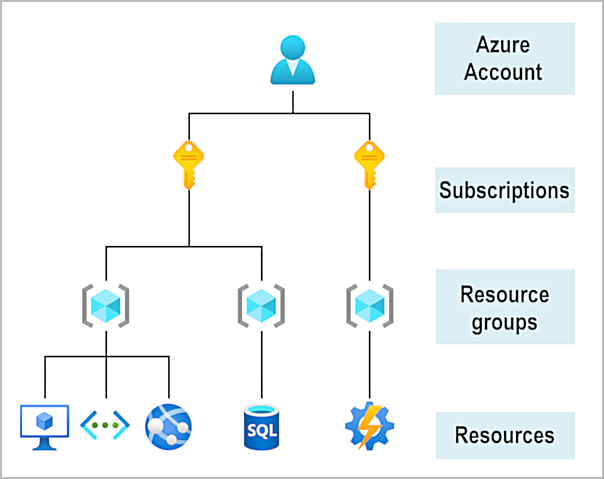
Azure Free Account
The Azure free account includes free access to popular Azure products for 12 months and a credit to spend during the first 30 days. Additionally, it gives customers access to more than 25 products, which are always free. This makes it an excellent option for new users to test Azure before paying for a subscription.
Azure 免費帳戶包含 12 個月內免費使用熱門 Azure 產品,以及前 30 天內可使用的額度。此外,還可讓客戶使用超過 25 種始終免費的產品。這使其成為新用戶在付費訂閱前測試 Azure 的絕佳選擇。
Azure Free Student Account
The Azure free student account gives students a $100 credit to utilize within the first 12 months, as well as free access to select Azure services and software developer tools. Also, students can sign up without using a credit card.
Azure 免費學生帳戶提供學生在前 12 個月內可使用的 100 美元額度,以及免費使用特定 Azure 服務和軟體開發工具。此外,學生註冊時無需使用信用卡。
Azure Physical Infrastructure
Azure's physical infrastructure is composed of data centers, which are the core components of the cloud platform. These data centers are divided into regions and availability zones to provide scalability, dependability, and resiliency to workloads.
Azure 的實體基礎設施由資料中心組成,這些是雲端平台的核心組件。這些資料中心被劃分為區域和可用性區域,以提供工作負載的可擴展性、可靠性和韌性。
Data Centers(資料中心)
Data centers are large facilities that contain resources in racks with specialized power, cooling, and networking. Azure maintains data centers worldwide, which are divided into regions and availability zones to improve application resiliency.
資料中心是大型設施,內含配備專用電力、冷卻和網路的機架資源。Azure 在全球維護資料中心,這些資料中心被劃分為區域和可用性區域,以提升應用程式的韌性。
Regions(區域)
Regions are geographical areas with many data centers linked by a low-latency network. Azure resources are deployed in certain regions, with some services only available due to performance or regulatory issues.
區域是由多個資料中心組成的地理區域,這些資料中心透過低延遲網路連接。Azure 資源部署於特定區域,部分服務因效能或法規問題僅在某些區域提供。
Availability Zones(可用性區域)
Availability zones are physically distinct data centers within a region. They are equipped with independent power, cooling, and networking to ensure high availability and fault tolerance by isolating workloads in case of failure in one zone.
可用性區域是區域內物理上獨立的資料中心。它們配備獨立的電力、冷卻和網路,以確保高可用性和容錯能力,透過在一個區域發生故障時隔離工作負載。
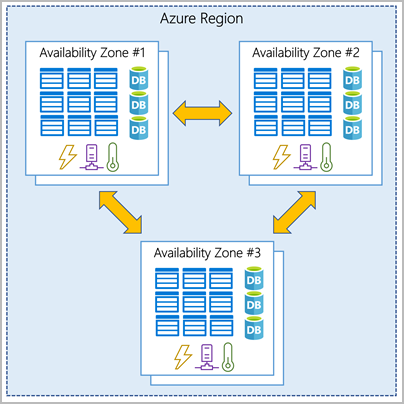
Region Pairs(區域配對)
Region pairs are made up of two regions that are at least 300 miles apart within the same geographical area. This configuration provides data replication and high availability, with one region acting as a backup for the other in case of a disaster.
區域對由同一地理區域內相距至少 300 英里的兩個區域組成。此配置提供資料複寫和高可用性,其中一個區域在災難發生時作為另一個區域的備援。
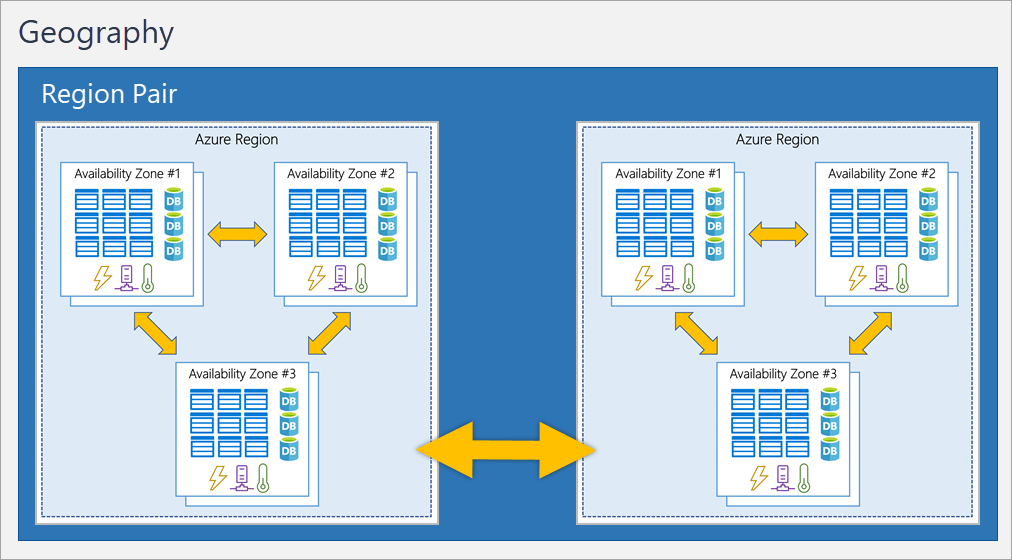
Sovereign Regions(主權區域)
Sovereign regions are isolated Azure instances that are used for compliance or legal purposes. These regions, such as the US Gov and China regions, are run independently of the main Azure infrastructure to fulfill special government or regulatory needs.
主權區域是為了合規或法律目的而設置的獨立 Azure 實例。這些區域,例如美國政府區域和中國區域,獨立於主要的 Azure 基礎設施運行,以滿足特定政府或監管需求。
Azure Management Infrastructure(管理基礎設施)
The Azure management infrastructure is the framework that organizes and manages resources, subscriptions, and accounts. It helps in the structuring of projects and products to provide efficient management within Azure.
Azure 管理基礎架構是組織和管理資源、訂閱及帳戶的框架。它有助於專案和產品的結構化,提供在 Azure 內的高效管理。
Azure Resources and Groups(資源與群組)
A resource in Azure is any entity that you create, deploy, or provision, such as virtual machines (VMs), databases, or networks. Resource groups are used to manage and implement actions such as deletion and access control.
Azure 中的資源是指您所建立、部署或配置的任何實體,例如虛擬機器(VM)、資料庫或網路。資源群組用於管理及執行刪除和存取控制等操作。
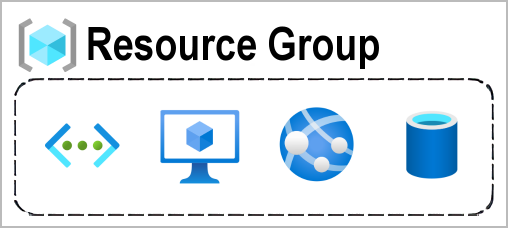
Azure Subscriptions(Azure 訂閱)
Azure subscriptions are used for management, billing, & resource scaling. They connect to an Azure account and allow you to organize resources, manage costs, and apply access control settings.
Azure 訂閱用於管理、計費及資源擴展。它們連接到 Azure 帳戶,讓您能夠組織資源、管理成本並套用存取控制設定。
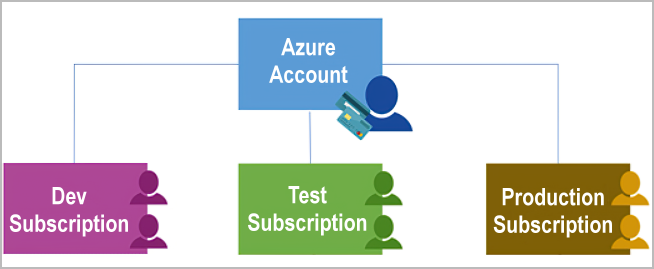
Billing Boundary(計費邊界)
This subscription type determines how an Azure account is billed. Multiple subscriptions can be created for different billing needs, with separate reports and invoices for each.
此訂閱類型決定了 Azure 帳戶的計費方式。可根據不同的計費需求建立多個訂閱,並為每個訂閱提供獨立的報告和發票。
Access Control Boundary(存取控制邊界)
Access policies are applied at the subscription level. Separate subscriptions can be created for different departments, enabling control over resource access and management.
存取政策是套用在訂閱層級。可以為不同部門建立獨立的訂閱,以便控制資源的存取與管理。
Create additional Azure subscriptions
(建立額外的 Azure 訂閱)
Additional subscriptions can be formed for different environments, organizational structures, or billing needs. This technique enables better resource separation and access management across departments or teams.
可以為不同的環境、組織結構或計費需求建立額外的訂閱。此方法能夠在各部門或團隊之間實現更好的資源分離與存取管理。
Environments(環境)
Create subscriptions to separate environments for development, testing, or compliance, as resource access is controlled at the subscription level.
建立訂閱以區分開發、測試或合規性的環境,因為資源存取是以訂閱層級進行控制。
Organizational Structures(組織結構)
Subscriptions can reflect different organizational structures, allowing access control and resource allocation based on team requirements.
訂閱可以反映不同的組織結構,允許根據團隊需求進行存取控制和資源分配。
Billing(計費)
Create subscriptions to manage and track costs, such as separating production and development workloads for better cost control.
建立訂閱以管理和追蹤成本,例如分開生產和開發工作負載,以便更好地控制成本。
Azure Management Groups(Azure 管理群組)
Azure Management Groups are more organized than subscriptions, enabling greater governance and access management. They allow centralized policy enforcement across many subscriptions and resources.
Azure 管理群組比訂閱更有組織性,能夠實現更完善的治理和存取管理。它們允許在多個訂閱和資源之間集中執行政策。
Management Group Hierarchy(管理群組階層)
Management groups can be nested to form a structure with a hierarchy for handling subscriptions and resources. This makes it easier to apply consistent policies along with access controls across large Azure environments.
管理群組可以巢狀組合,形成一個用於管理訂閱和資源的階層結構。這使得在大型 Azure 環境中更容易套用一致的政策及存取控制。
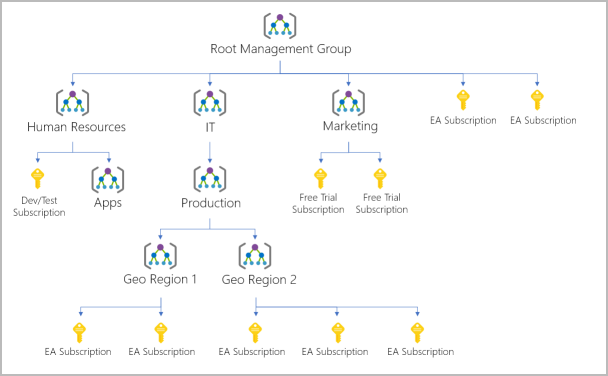



留言
張貼留言